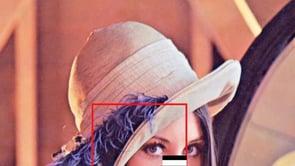OpenCVの顔検出器の検出過程を可視化した動画。
ここで使われているアルゴリズムはViola-Jones法。この手法による顔検出のポイントは、以下の2つのステップ。
- 前処理:大量の学習データを用いたAdaBoostによる識別器の学習
- 高速な検出処理:Haar-Like特徴量を用いたCascade構造の識別器で画像中を高速全探索
弱い識別器を連結したCascade型の識別器でザルのように順に画像を選別していく。
弱い識別器の集合で強い識別器を作る方法は、集団学習とかアンサンブル学習とか呼ばれる。
この動画では、赤い枠で走査して、枠内のピクセルをCascadeに通過させて識別している様子が可視化されている。
もともとこの動画は、一般的な顔認識で検知されないようにするためのメイク & ヘアスタイル『CV Dazzle』の解説の一部らしい。
This video visualizes the detection process of OpenCV’s face detector.
The algorithm uses the Viola Jones method of calculating the integral image and then performing some calculations on all the areas defined by the black and white rectangles to analyze the differences between the dark and light regions of a face.
The sub-window (in red) is scanned across the image at various scales to detect if there is a potential face within the window. If not, it continues scanning.
If it passes all stages in the cascade file, it is marked with a red rectangle. But this does not yet confirm a face. In the post-processing stage all the potential faces are checked for overlaps.
Typically, 2 or 3 overlapping rectangles are required to confirm a face. Loner rectangles are rejected as false-positives.
This visualization was done as part of the documentation for CV Dazzle, camouflage from face detection.
For more information, visit cvdazzle.com
http://japanese.engadget.com/2011/03/17/cv-dazzle/
参考:コンピュータビジョンのセカイ – 今そこにあるミライ
http://news.mynavi.jp/series/computer_vision/010/
http://news.mynavi.jp/series/computer_vision/011/
2014/08/20追記:
【動画】Adaboostによる顔検出アルゴリズムの様子がよくわかるCUDAのデモ
関連記事
OpenVDB:3Dボリュームデータ処理ライブラリ
CycleGAN:ドメイン関係を学習した画像変換
SVM (Support Vector Machine)
NeRF (Neural Radiance Fields):...
Raspberry Pi 2を買いました
Raspberry PiのGPIOを操作するPythonライ...
OpenSfM:PythonのStructure from ...
ZScript
Mask R-CNN:ディープラーニングによる一般物体検出・...
Mitsuba 3:オープンソースの研究向けレンダラ
bpy-renderer:レンダリング用Pythonパッケー...
OpenCV 3.3.0 contribのsfmモジュールの...
CNN Explainer:畳み込みニューラルネットワーク可...
konashiのサンプルコードを動かしてみた
Blender 2.8がついに正式リリース!
adskShaderSDK
Pylearn2:ディープラーニングに対応したPythonの...
HD画質の無駄遣い その2
1枚の画像からマテリアルを作成できる無料ツール『Materi...
Point Cloud Consortiumのセミナー「3D...
Raspberry Piでセンサーの常時稼働を検討する
OpenMVSのサンプルを動かしてみる
iPhoneアプリ開発 Xcode 5のお作法
Houdiniのライセンスの種類
ドットインストールのWordPress入門レッスン
写真に3Dオブジェクトを違和感無く合成する『3DPhotoM...
OpenAR:OpenCVベースのマーカーARライブラリ
畳み込みニューラルネットワーク (CNN: Convolut...
openMVGをWindows10 Visual Studi...
ブラウザ操作自動化ツール『Selenium』を試す
Unityの各コンポーネント間でのやり取り
Amazon EC2ログイン用の秘密鍵を無くした場合の対処方...
フィーリングに基づくタマムシの質感表現
UnityのTransformクラスについて調べてみた
Model View Controller
ROSの薄い本
C++始めようと思うんだ
ニューラルネットワークと深層学習
COLMAP:オープンソースのSfM・MVSツール
viser:Pythonで使える3D可視化ライブラリ
UnityのGameObjectの向きをScriptで制御す...
Adobe MAX 2015



コメント